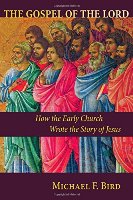Reviewed by Patrick Schreiner
Introduction
A myriad of questions surround the formation of the Gospels: questions such as, how was the tradition passed on? What role does memory play? Who controlled it? What is the relationship between the Gospels? Mike Bird’s latest book seeks to answer these questions, surveys recent research on these issues, and provides some of his own critical feedback. This book is not about the Gospels per se, but rather about the formation of the Gospels.
The book is needed for at least two reasons. First, because the Gospels are a unique type of literature in the NT which require reflection. Jumping into interpretation without at least an elementary understanding the process of their composition, transmission, and purpose can lead to regrettable conclusions. Second, Bird addresses areas of study that have been transformed in the last 30 years. A comprehensive yet readable book is required for those who wish to stay up to date on the issues, and Bird has provided a winsome yet thorough review of the literature.
Bird structures his book around the following:
1) From Jesus to the Gospels
2) The Purpose and Preservation of the Jesus Tradition
3) The Formation of the Jesus Tradition
4) The Literary Genetics of the Gospels
5) The Genre and Goals of the Gospels
6) The Fourfold Gospel.
Interspersed in these subjects is a discussion of the non-canonical Gospels, form criticism, an evangelical yet critical approach to the Gospels, patristic information on the order of the Gospels, and the Gospels in the second century.
Analysis
I have very little to critique in Bird’s book. I found it an enjoyable read, well researched, fair, and a good source for trends in Gospel scholarship. I do have one suggestion that I will mention at the end, but overall this is a book every pastor and teacher should have on their shelf. It introduces one to numerous discussions and provides a copious amount of footnotes for further study. Some highlights should help a reader see the value in Bird’s book.
First, a hot topic in Gospels scholarship is movement away from the literary relationships of the Gospels and interest in oral tradition and transmission. Bird rightly plants his feet on both sides of the chasm arguing there should be mutual analysis. He asserts the relationship between orality and textuality is fluid rather than detached. Social memory theory can be helpful when thinking about the past not simply being a cognitive store and retrieve center; rather past memories are reconstructed in light of the present. This does not mean the past is trampled by the present, for they work in concert. If one is prone to only look at oral tradition, Bird also shows that although the Synoptic problem is a tired field, there is a clear literary relationship between the Gospels. He proposes a modified model of the two/four source hypothesis, leaving room for more complexity than many views allow.
Second, Bird covers topics such as the genre of the Gospels, asserting they look most like Greco-Roman biographies but also acknowledging they have kerygmatic functions. I loved his discussion of the titles of the Gospels. Largely following Martin Hengel, he contends that there is good reason to think that the attribution of names to the Gospels occurred very early, perhaps as early as the last decade of the first century. He also follows Gathercole in arguing for an early long form “The Gospel according to X” rather than the short form “according to x.”
Third, Bird helpfully surveys differing views on scholarly issues both inside and outside evangelicalism. He does not accept a point of view simply because it does or does not come out of his camp. He critically thinks through the arguments and provides critique when needed.
My only critique of Bird’s book is that he could have thought more (for pedagogical purposes) about a “loose” blueprint. In other words, why not move towards a categorization of the stages of transmission as Watson has done. Obviously much of this is guess work, but a good guess can be given for the passing on of any tradition. For example here is Francis Watson’s proposal in Gospel Writing.
Pre-Written
Datum > Recollection > Tradition
Written
Inscription > Interpretation > Normativization
Mark Allan Powell gives the following description in his Introduction to the Gospels.
The Historical Jesus > Early Tradition > Redaction of the Gospels
> Preservation of Manuscripts > Translation > Reception
Both models have their strengths and weaknesses, and a problem with putting it so straightforwardly is that it may bypass complexity. My (initial) preferred outline would be the following with a smaller “interpretation + reception” listed in between each stage.
Event > Memory > Tradition > Inscription > Normativization
My point is that Bird could have more explicitly structured his book around something like this. Titles like “The Formation of the Jesus Tradition” could be conceived as being located in any of these steps and leaves something wanting in a conceptual framework for the book.
Recommendation
The book is worth a purchase if not simply for an introduction to a wide variety of conversations that are occurring around the Gospels. Much more could be said about the strengths of the book, but I will leave you with a line Bird gives towards the end of the book intending to spur people on in the study of the Gospels.
“Young and ambitious theologians, especially those concerned with relating the text to the missional situation of the church in twenty-first century, would be wise to keep exploration and exegesis of the fourfold Gospel uppermost in their studies.”
Tolle lege.
Patrick Schreiner is Instructor of New Testament Language and Literature, Western Seminary.
Note: You may like to see our interview with Michael Bird on his How God Became Jesus: The Real Origins of Belief in Jesus’ Divine Nature – A Response to Bart Ehrman.
